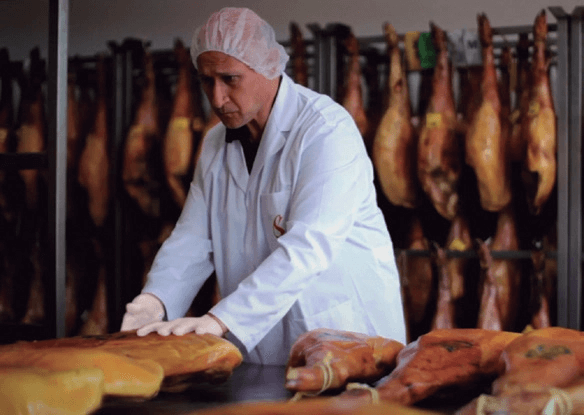ABOUT CONSORCIO SERRANO
Spanish Consorcio Serrano Ham requires, above all else, the finest raw material and is guaranteed by scrupulous purchasing policy of its associates and the strict compliance with product standards and regulations, as defined in the quality control standards of the Consorcio itself.
These standards require raw material with thicker fat in the most critical points and the right amount of fat on the leg as a whole, making it suitable for the level of curing that a Consorcio Jamón Serrano Ham requires.
This is accompanied by a piece by piece visual inspection to discard any legs with defects that make them unsuitable for the curing process.
Once delivered, the fresh ham (raw material) to be used for producing the Consorcio Serrano Ham is classified by weight and fat content. This is done at the production plants of the member companies, after which they are cooled before being covered in salt. This implies that the ham must not exceed a temperature of 5ºC when they are immersed in the salt.
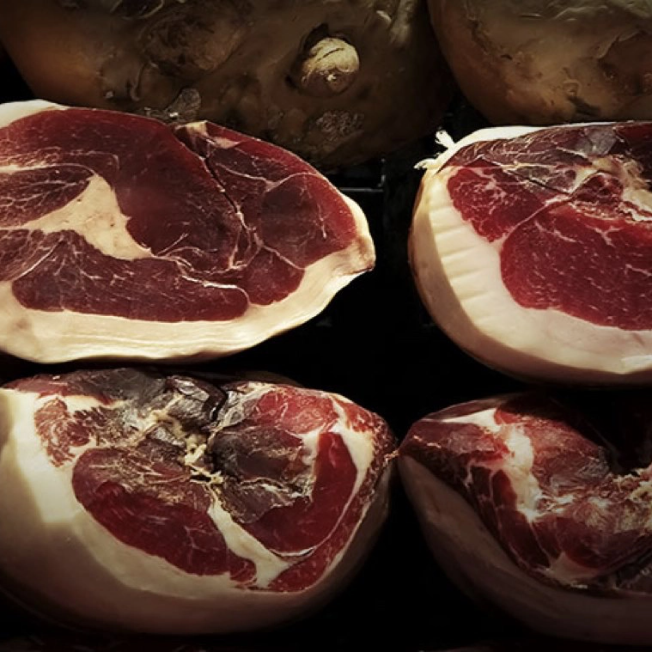
Control of this first phase of microbiological stabilization of the fresh Serrano ham under low temperatures and high humidity is the most important to make sure that the elaboration of the piece is optimal in later elaboration phases. The next steps are:
- Salting and post-salting: in this stage, the fresh ham is covered in sea salt, which aids dehydration and conservation of the Serrano ham pieces.
- Drying and maturation: in this stage, the temperature is gradually raised and humidity reduced, thus achieving a natural fusion of part of the fat from their protective adipose layer. Hence the fats are evenly distributed throughout the muscle tissue, which develops the sensory characteristics (colour, aroma and taste) synonymous with Spanish Serrano ham.
- Aging in the cellar: this is the final stage in the curing process of the Serrano ham, where the ham slowly finishes maturing, reaching the point where it becomes the gourmet product that it is.
- Selection: once the Serrano ham is ready for market, a team of inspectors from the Consorcio del Jamón Serrano Español selects the hams one by one. They consider their shape and organoleptic characteristics, ensuring they meet all the requirements outlined in our quality standards.
- Sealing: all of the Serrano hams that pass our selection process are given the Consorcio Serrano seal of quality. This seal is the best way to promote Serrano ham internationally.
At the end of the elaboration cycle, which usually lasts between one year and a year and a half, the resulting product is a Consorcio Serrano Ham with exceptional organoleptic and sensory qualities, unmistakable for its colour, aroma, appearance and texture.
The Consorcio performs annual audits at the member production plants to monitor and control all aspects of the production process. The Consorcio Serrano Ham production process is governed by a set of parameters:
- Maturing period: With an average maturation period of 12 months, and a minimum of 9 months, from the moment the ham is immersed in the salt.
- Losses: the hams produced according to the Con- socio’s guidelines will lose over 34% of their humidity, depending on their weight when fresh. This ensures that the ham develops the required properties, such as its texture.
•Fat content: This is important for the development of the sensory properties and to ensure the quality of Serrano hams are properly cured.
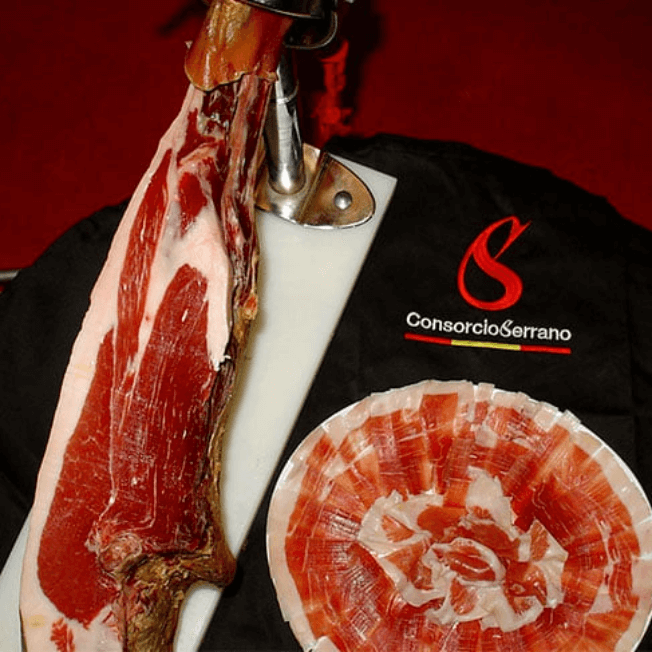
What guarantees a Consorcio Serrano Ham?
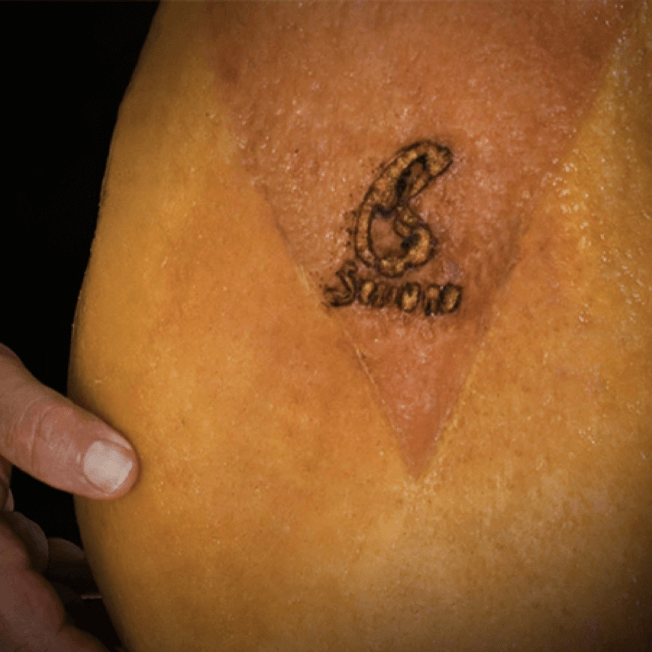
The Quality Control Department of the Consorcio del Jamón Serrano Español, via quality control and selection piece by piece, seeks to guarantee a product that not only is of high quality but is also homogeneous, with a unique texture, smell and taste that identifies genuine
Spanish cured ham as remaining constant over time. Only a limited amount of Spanish Serrano Hams are worthy of the “Exclusive Signature” or Consorcio Serrano Quality Seal.
This Seal is only reserved for those Spanish Serrano Hams that comply with the following quality guidelines: Compliance with the quality standard of the Consorcio del Jamón Serrano Español.
The production process of Serrano ham takes place exclusively in Spain.
European TSG (Traditional Speciality Guaranteed) certification, which protects the “Jamón Serrano” designation. Average maturation of 12 months (minimum maturation time: 52 weeks).
Control of the facilities by periodic inspections and audits of the process and product at every production plant.
Quality guarantee on each piece of Serrano ham using a numbered control label.
Why Consorcio Serrano ham?
There is a large variety in the quality of Serrano ham. The Consorcio del Jamón Serrano Español is the asso- ciation of Spanish producers of Serrano ham that has guaranteed quality with their control seal since 1990.
100% Serrano ham from Spain, matured for an average of 12 months. Thorough quality control in traditional production processes Piece by piece ham selection at the prime moment for consumption
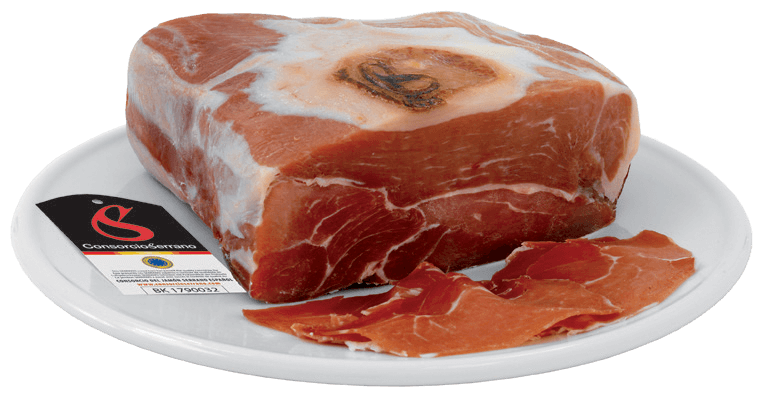
Origins of Serrano Ham
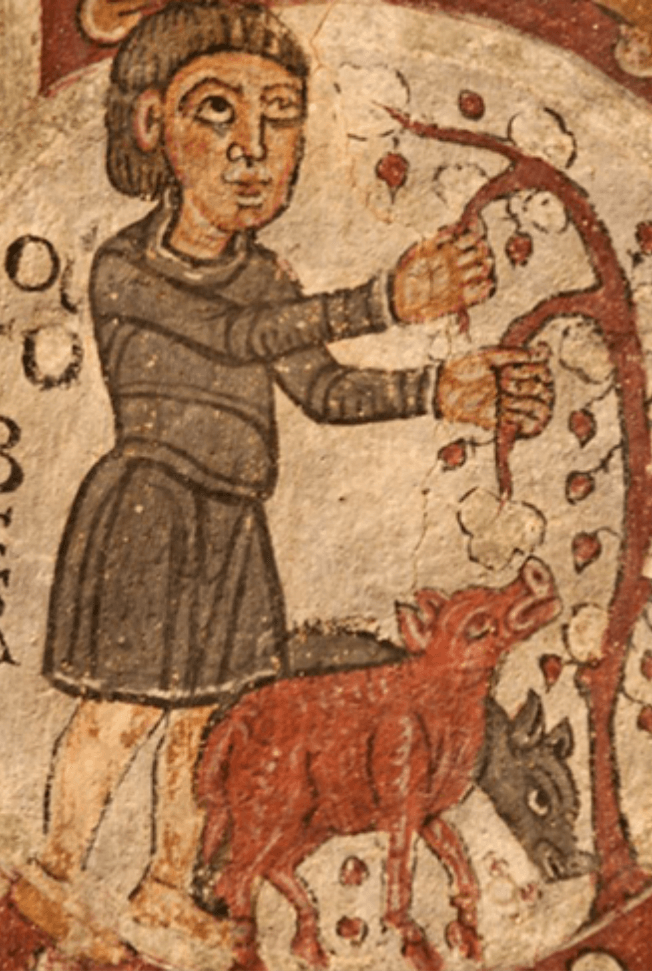
Cured ham, Serrano ham especially, forms part of the history of Spain and is one of the essential elements of its cultural context. Going back to the ancient Celts, pork was a basic product in their nutrition and was even considered a sacred object. This trading person placed it among the principal and most important merchandise. Elaborately carved sculptures of pigs guarded the borders of their domains and paths and were erected in funeral monuments that protected the rest of the distinguished dead.
Later, the Romans, respectful of the cultures and traditions present in the territories they incorporated into their Empire, fell in love with the Iberian delicacy. They im- but the culinary delights of the peninsula and enriched the cultural baggage with pork symbolism and history.
The ham, the most valuable, juicy, tasty part of the animal, was reserved for the wealthy classes. There were many cooks specialising in the preparation of hams and other cured meats referred to as “vicarious supra” dinners.
The importance of the trade-in cured ham during Roman times was so great that during the reigns of Augustus and Agrippa ham shaped Roman coins were minted.
During the Middle Ages and the Modern Age, pork continued to be consumed in abundance, as meat or as cured sausage since it was so easy to breed because it is an omnivore animal and owing to its rapid reproduction. The killing of the pig has, in fact, been one of the most important festivities in rural regions across Europe.
Finally, Serrano ham reached its peak in the 19th cen- try and the first half of the 20th thanks to the development of technology for meat product elaboration, propelled by the industrialisation and liberalisation of European commerce.
Seal of quality of the Consorcio del Jamón Serrano Español
Serrano ham bearing the “Consorcio Serrano” seal of quality is guaranteed to have been produced in line with the association’s demanding quality standards and have passed rigorous quality controls so that they can be exported.
This Seal guarantees a traditional, unique ham, always elaborated in Spain with 100% Spanish raw materials. Its sensory qualities (essentially, texture and taste) differentiate it from other Serrano hams, as well as other cured products such as Prosciutto di Parma or Bayonne Ham that can be found on the foreign market, due to its excellence and refinement.
This Seal can be found on all Serrano ham products, no matter their presentation:
In whole pieces of Serrano ham, branded onto the piece.
Sliced Serrano ham.
The numbered control label.
Only a limited production of hams is awarded the “Exclusive Signature”.
The Consorcio del Jamón Serrano Español is one of the most important ham-producing associations in Spain that guarantees that all Serrano ham is marketed under the “Consorcio Serrano” countermark comply with the strict- est quality standards. Only a limited amount of Spanish Serrano Hams are worthy of the “Exclusive Signature”.
This quality guarantee is what has gained the trust of importers, distributors, and consumers, and helped Consorcio to seal 14.000.000 pieces of Serrano ham in July 2017.
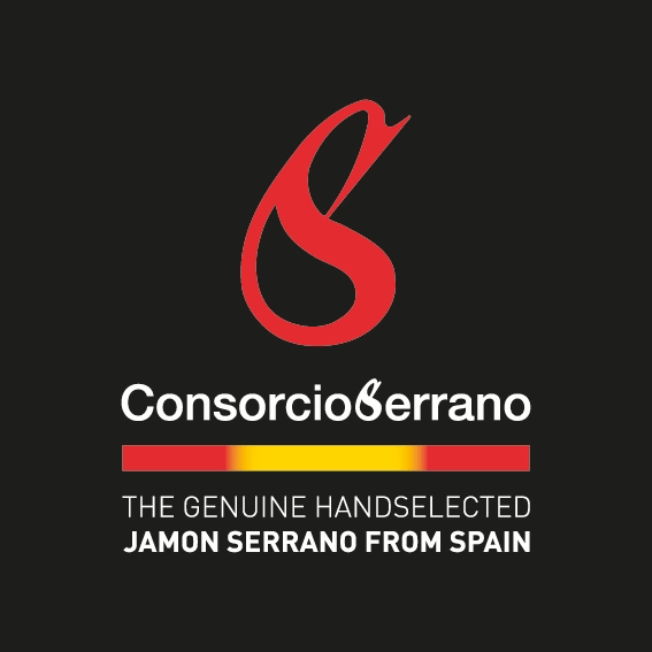
What is the difference between Serrano ham and prosciutto?
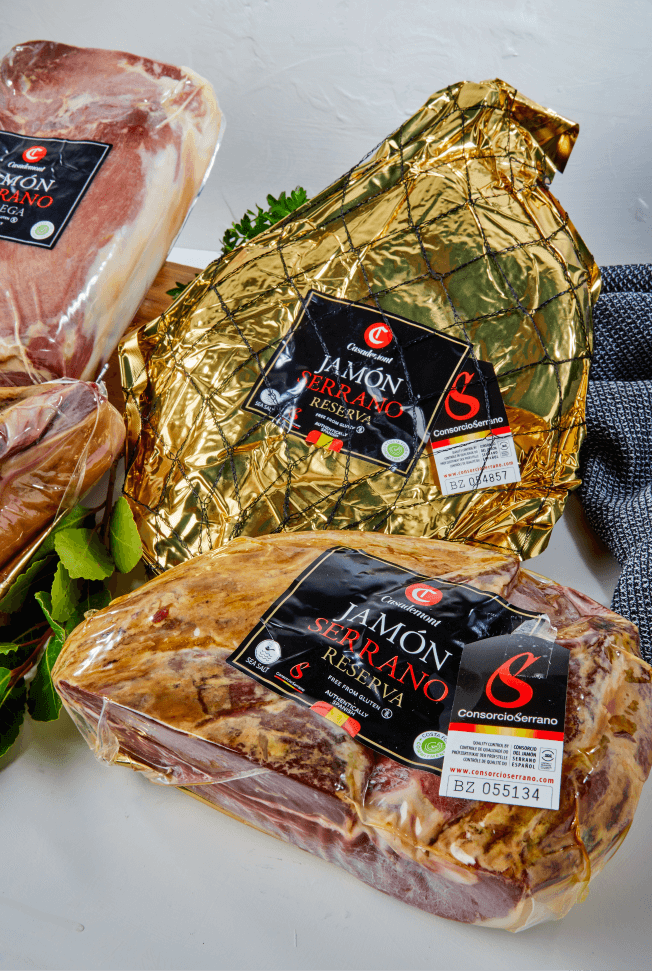
Anyone who is not familiar with cured ham may find it complicated to differentiate between Serrano ham and prosciutto. Both are cured hams from white pigs, but each with very unique characteristics. To help anyone who wonders whether to buy Serrano ham or prosciutto when at the supermarket, here are some key points:
Let’s start with geographic location; prosciutto is a tra- ditionally Italian product, with a spotlight on Prosciutto di Parma and Prosciutto di San Daniele. On the other hand, Serrano ham is a Spanish product that shares its geographical origin with another well-known cured ham: Iberian ham (jamón ibérico), also known as pata Negra ham.
Another point to keep in mind is maturation. Maturation time and process determine the quality, texture and organoleptic qualities of the ham. Not all Serrano ham, nor prosciutto, goes through the same process nor has the same time of maturation. This maturation process can vary from 9 months to two years, ideally in a curing room in contact with the open air.
Traditionally, Italian cuisine has given more emphasis to prosciutto in its dishes than Spanish cuisine has to Serrano ham, which is a higher-quality food product in general. But in addition, nowadays you can find classic combinations of prosciutto with pasta, pizza, fruit, brochettes; there is also an extensive culture of Spanish cooking recipes with Serrano ham.
In Spain, Serrano ham has traditionally been enjoyed as a side dish only with good wine and bar tapas, although more and more it has been incorporated into various Spanish recipes, giving credence to the concept of “gourmet ham”.
You can always recognise Consorcio Serrano Ham by:
• The Quality Seal.
• The logo of the Consorcio del Jamón Serrano Español.
• The numbered control label.
• Only a limited amount of Spanish Serrano Hams are worthy of the Consorcio Serrano Quality Seal
